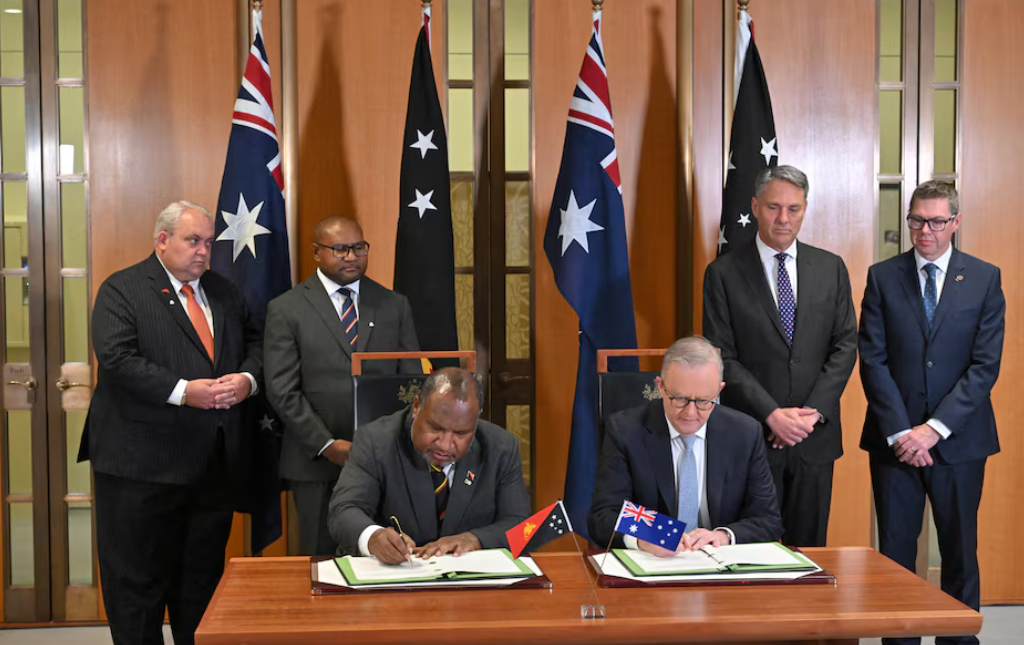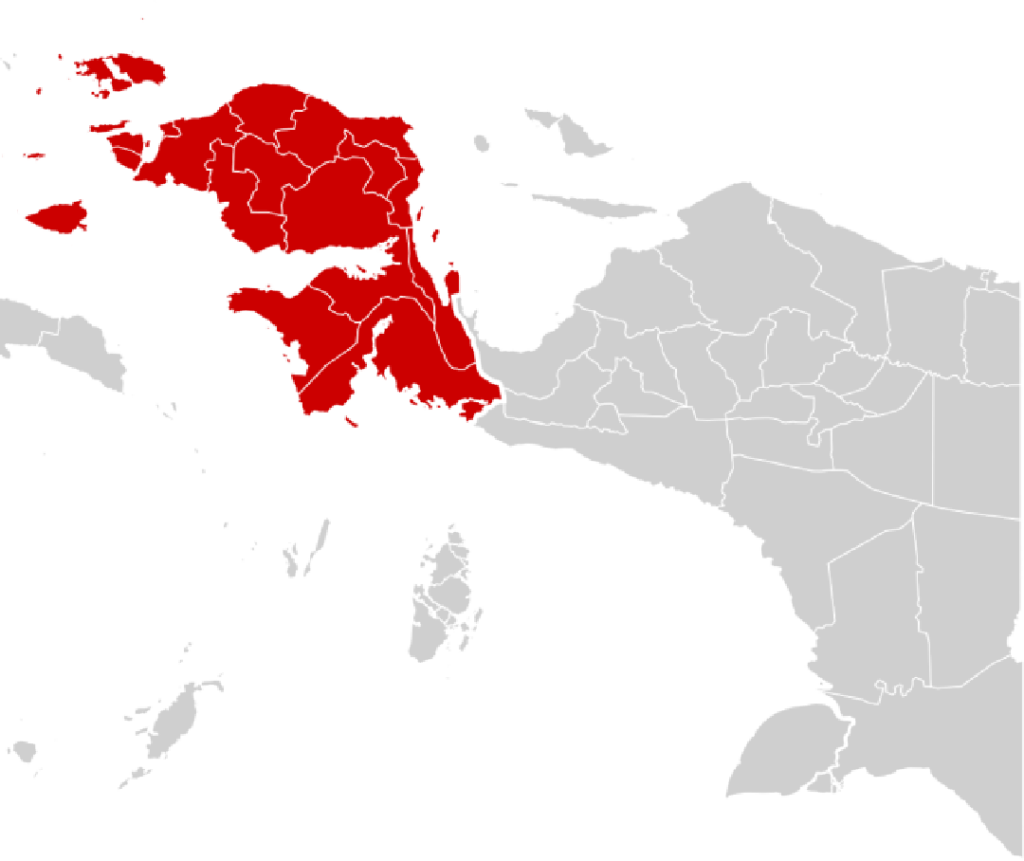The Pacific is shifting. Strategic lines are being redrawn, and new alliances are crystallizing. On the surface, the recent defense pact between Australia and Papua New Guinea (PNG) might seem like a bilateral agreement meant to address mutual concerns. But scratch beneath that surface, and it becomes clear: this is not just a security deal. It is a geopolitical maneuver that reverberates well beyond Canberra and Port Moresby—and into Indonesia’s sensitive eastern frontier: Papua.
The newly signed agreement opens the door for 10,000 Papua New Guineans to be trained and absorbed into the Australian military as part of a larger regional security architecture. While Australia frames this move as a response to emerging global threats and to counterbalance China’s influence in the Pacific, the pact introduces a deeper set of challenges for Indonesia. Most critically, it raises concerns about sovereignty, border stability, and separatist exploitation in Papua—a region that already sits at the heart of Indonesia’s most sensitive territorial discussions.
A Treaty That Changes the Strategic Landscape
On October 6, 2025, Australia and PNG formalized a historic defense cooperation treaty—some media even likened it to a “mini-NATO” for the Pacific. This pact allows for:
- Joint military training and interoperability;
- Shared intelligence and logistics platforms;
- Australia’s access to PNG territory for defense operations and deployments;
- And most controversially, the integration of up to 10,000 PNG nationals into the Australian Defence Force (ADF).
According to Australian officials, this arrangement is not about conflict but about “readiness” in a world where the Pacific has become a theater of major-power competition. Yet, the strategic implications are unmistakable. This deal gives Australia a forward-operating presence directly on the doorstep of Indonesia’s Papua region—a part of Indonesia already rife with separatist tensions and complex geopolitical sensitivities.
Indonesia’s Sovereignty Concerns in Papua
The pact brings a legitimate anxiety to Jakarta’s doorstep: What happens when foreign military personnel and assets are stationed just kilometers away from Indonesia’s most volatile provinces?
For decades, Indonesia has faced challenges in its governance of Papua, including periodic outbreaks of insurgency by separatist groups like the Free Papua Movement (OPM). Border areas between Papua and PNG are historically porous, with known cross-border movement of militants, smugglers, and sympathizers.
With PNG now positioned as a formal military ally of Australia, and by extension a possible vector for foreign power projection, Indonesia fears that Papua could become a pressure point in great power competition. If unrest flares, would foreign powers remain neutral? Could separatist groups gain indirect moral—or worse, logistical—support under the umbrella of humanitarian or “security monitoring” just across the border?
While no official statements from Canberra suggest interference in Indonesia’s domestic affairs, the optics matter. The symbolism of 10,000 PNG troops trained by Australia and stationed near the Indonesian border changes Jakarta’s perception of regional balance. Indonesia has traditionally maintained strategic autonomy, avoiding permanent foreign military presence on its soil and rejecting any suggestion of internationalization of the Papua issue.
Now, it may no longer have the same luxury of distance from foreign-aligned military presence.
A Narrowing Buffer Zone
For decades, the geographical separation between Indonesia and core Western military assets provided a kind of strategic buffer. The Philippines leaned toward the U.S., and Australia maintained its alliances—but both were comfortably distant. The Pacific islands, including PNG, were largely non-aligned, acting as political and strategic neutral zones.
That buffer has now narrowed.
Australia’s military reach has extended northward. Its alliance with PNG, a country that shares a land border with Indonesia, effectively places an ally of a Western defense structure adjacent to a historically contentious area of Indonesia. Strategically, this reduces Indonesia’s depth—both in terms of reaction time to military movement and in its diplomatic room to maneuver in Papua.
Indonesia now faces a reality where foreign surveillance, cyber capabilities, and intelligence-gathering infrastructure could be much closer to home. Even if no hostile actions occur, the potential for miscalculation or misinterpretation is significantly increased.
Risks of Escalation and Regional Destabilization
The Australia–PNG pact does more than alter bilateral dynamics—it accelerates a broader militarization trend in the Indo-Pacific. Similar to the AUKUS alliance (Australia, UK, US), this deal furthers a pattern of tightening Western military alliances aimed at counterbalancing China.
China, unsurprisingly, has voiced strong objections, with officials hinting that PNG could become a “staging ground” for foreign military pressure on Beijing’s interests in the Pacific. Yet, it is not just China that may feel boxed in. Indonesia is now caught between intensifying power blocs, a situation it has long sought to avoid.
There’s also a risk of proxy dynamics. In fragile border regions like Papua, where trust between the state and some indigenous populations remains low, separatist actors might find new narratives—if not outright support—to frame their struggle as part of a broader geopolitical tug-of-war. The situation could evolve from a localized independence campaign to something framed in global ideological or strategic terms.
The View from Port Moresby: Between Sovereignty and Security
From PNG’s perspective, the defense pact represents a moment of empowerment and modernization. Papua New Guinea has long struggled with underdeveloped defense capabilities and internal instability. The opportunity to train thousands of its youth in Australia’s military, gain defense infrastructure, and ensure border protection is understandably attractive.
Yet even within PNG, the agreement has drawn criticism. Former PNG military chief Jerry Singirok warned that the country risks becoming “a puppet” or proxy in a conflict it does not control. He questioned the wisdom of handing over such deep access to Australian forces—raising fears of sovereignty erosion.
These internal debates within PNG echo similar concerns in Jakarta: when a small country signs a pact with a great power, who really sets the terms in the long run?
Indonesia’s Options: Caution, Engagement, and Recalibration
So what can Indonesia do in the face of these developments?
- Diplomatic Engagement
Indonesia should immediately open quiet backchannels and formal talks with both PNG and Australia, not to contest the pact, but to seek clear assurances:
- That no operations will target or influence Papua;
- That military activities near the border will be transparently coordinated;
- That PNG will not allow its territory to be used for any activity that threatens Indonesian sovereignty.
- Defensive Posture
Without escalating tensions, Indonesia can strengthen border monitoring, enhance civil-military cooperation in Papua, and boost community engagement programs to reduce separatist influence. By showing it can maintain control and stability, Indonesia nullifies any excuse for foreign “concern” or interference.
- Multilateralism
Indonesia could leverage ASEAN and Pacific Islands Forum platforms to promote non-alignment, anti-militarization norms, and mutual respect for sovereignty. Encouraging regional codes of conduct or joint security declarations could build a new diplomatic firewall against great-power interference in local conflicts.
- Strategic Partnerships
Indonesia should consider enhancing security cooperation with neutral or like-minded states—such as India, Japan, or even Pacific Island nations—focusing on maritime security, humanitarian cooperation, and anti-smuggling efforts, rather than overt military alliances.
The Role of Public Diplomacy and Perception
At the core of the Papua issue is not just geopolitics, but perception. Indonesia must ensure that global audiences do not equate the Australia–PNG pact with international oversight of Papua. Indonesia’s development work, infrastructure investment, and autonomy frameworks in Papua need stronger communication globally. The narrative must be reclaimed and reshaped—not by censorship, but by clarity and transparency.
Conclusion
The Australia–Papua New Guinea defense pact is a strategic milestone that could reshape Pacific security. But its implications go far beyond bilateral cooperation. For Indonesia, especially in the context of Papua, this treaty represents a moment of recalibration—of its borders, its diplomacy, and its strategic thinking.
The stakes are high. Mishandled, this situation could stoke nationalist fires, embolden separatist narratives, or escalate regional tensions. Managed with care, however, it could prompt a new era of regional dialogue—where sovereign rights, development priorities, and cooperative security coexist.
In the shifting waters of Pacific geopolitics, Indonesia must navigate not with fear, but with foresight.


